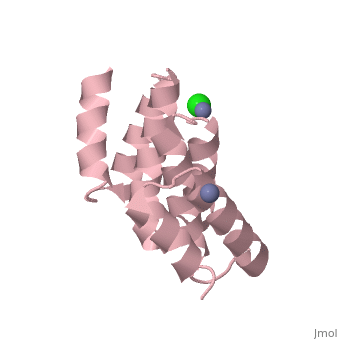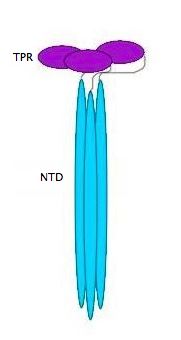Structure
YbgF is a periplasmic protein with an N-terminal coiled coil domain (NTD) and a C-terminal tetratricopeptide domain (TPR), both of which are autonomous[1]. As seen in the , the NTD forms an elongated trimer which is connected via a flexible linker to the TPR trimer, . This connection can be cleaved by proteases[2].
Function
Although YbgF is conserved in most gram-negative organisms, the exact function of this protein is still unknown. It may be involved in the late stages of cell division when the Tol complex is recruited to the area of septation, or also during invagination[2].
It is known that YbgF interacts with the C-terminal domain of TolA during the import of Colicin A into the cytoplasm[3]. The TPR domain in YgbF has been shown to bind to domain II in TolA, with the binding site located between residues 280-313[1]. The NTD is not directly involved with the binding to TolA, but is important for the transition of YbgF in its oligomeric state when binding to TolA. This may be due to the NTD restricting the formation of the trimer state, allowing the TPR to bind with TolA[2].
Studies have shown that inactivation of the YbgF gene results in no discernible change in the activity of Tol[3]. Therefore, replacing the protein with another would not rescue any lost function. Future research may look into comparison of different gram negative bacteria in order to determine if the function is conserved. One particular organism that is known to not have this domain conserved is Chlamydiae[2]. Future research may look into the functioning of its Tol system, with a the possible addition of the YbgF domain to study what effect this might have.
3D structures of Ybgf
2wz7, 2xdj – Ybgf N terminal – Escherichia coli
2xev – Ybgf TPR domain – Xanthomonas campestris


